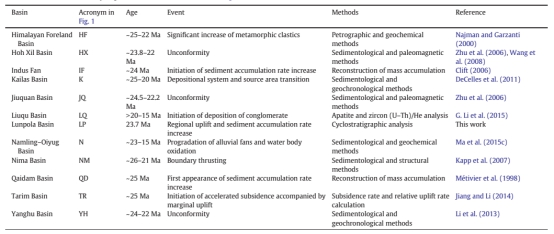连续湖相沉积记录对青藏高原中部伦坡拉盆地晚渐新-早中新世演化的约束
Late Oligocene-early Miocene evolution of the Lunpola Basin, central Tibetan Plateau, evidences from successive lacustrine records
青藏高原的隆升及其在全球和区域尺度上的气候效应,是新生代以来地球演化历史上最令人瞩目的事件之一。目前为止,大多数已经发表的研究在约束高原演化过程中的重要地质事件时缺乏高分辨率年代控制,这对深入了解高原其生长过程和机制造成了障碍。而湖泊盆地的演化对区域构造和气候事件非常敏感,其内部连续沉积的湖相地层可能是解决上述问题的关键。
本研究选择位于青藏高原中部、且研究程度较高的伦坡拉盆地作为目标,对盆地内部的多条露头剖面和钻井开展综合研究(图1)。首先,利用沉积学和地层学的基本方法,建立了晚渐新-早中新世层位的综合地层格架;随后,结合凝灰岩锆石年代、使用旋回地层学的方法,对露头剖面的孢粉数据和钻井剖面的测井数据进行分析,进而分别在盆地边缘和中心建立了高分辨率的年代地层格架(约 25.4-18.0 Ma);最后,在上述结果基础上对研究剖面已发表数据进行了汇编(图2)。获得以下主要认识:
1. 伦坡拉盆地区域在23.7 Ma发生区域构造抬升事件,并至少持续了约1 Ma;同时发生了盆地演化事件,具体表现为滨浅湖和深湖沉积速率同时倍增(图2);约0.2 Ma之后,发生了区域干旱事件(图2);
2. 区域构造抬升造成了紧邻盆地物源区剥蚀量的增加,从而导致了盆地沉积速率的剧烈变动;海拔高度的逐渐升高也是干旱事件的最直接控制因素;
3. 总结青藏高原内部及周边沉积盆地构造事件发现,伦坡拉盆地连续沉积地层记录的23.5 Ma构造事件可能不仅仅是个例,而是青藏高原发生重大构造演化事件的区域响应。
本研究不仅为约束青藏高原渐新-中新世构造事件提供了关键的年代学证据,也可以作为研究其他构造活跃区演化历史的重要参考。

图1 伦坡拉盆地大地构造及区域地质图(C中标注了研究中使用的露头剖面和钻井位置)

图2 伦坡拉盆地晚渐新-早中新世层位基础地质资料汇编及构造、气候和盆地演化事件标定
表1 青藏高原内部及周边沉积盆地渐新-中新世构造事件汇编

本研究受上海市自然科学基金(17ZR1432400)、海洋地质国家重点实验室基金(MG20160409)以及国家自然科学基金(41504059, 41676050)等资助。
主要作者及主页:
马鹏飞(同济大学):https://www.researchgate.net/profile/Pengfei_Ma4
王成善(中国地质大学(北京)):http://www.cugb.edu.cn/profAbout.action?zgh=2004011891
马超(犹他大学):https://www.researchgate.net/profile/Chao_Ma19
Citation:Ma, P., Wang, C., Meng, J., Ma, C., Zhao, X., Li, Y., Wang, M., 2017. Late Oligocene-early Miocene evolution of the Lunpola Basin, central Tibetan Plateau, evidences from successive lacustrine records. Gondwana Research 48, 224-236.
全文链接:http://www.sciencedirect.com/science/article/pii/S1342937X17300291
Abstract:Widespread Cenozoic sediments in and around the Tibetan Plateau (TP) are thought to have played an important role in explaining the process of the India-Asia collision as well as its interactions with global and regional paleoclimate. However, high-resolution temporal frameworks of sedimentary sequences and controls on geological and climatic events are still absent. To study the abovementioned issues, we investigate the Oligocene-Miocene lacustrine sequences (the Dingqinghu Formation) of the Lunpola Basin, central TP. In this work, cyclostratigraphic analyses are conducted with gamma ray log and pollen data to establish a high resolution temporal framework ranging from ca. 25.4 to 18.0 Ma for the sections. Along these sections, sediment accumulation rates are calculated with orbital signals to monitor clastic input of the lake basin; elemental, palynological, and isotopic data are summarized to depict the paleoclimate and paleoelevation evolution of this drainage system. Integrating all these clues together, we sort out a chronological list of events including lake basin, tectonics, and paleoclimate: regional uplift took place at 23.7 Ma; simultaneously, a distinct lake-basin transition characterized by accelerated sediment accumulation rate is recognized; about 0.2 Ma later at 23.5 Ma, catchment scale drought occurred and maintained to the end of the sections. Our results demonstrate that paleoclimate did not impose decisive influence on the late Oligocene-early Miocene evolution of the lake basin; instead, regional uplift and its associated accelerated exhumation of the source area resulted in the lake-basin transition and paleoclimatic drought. After reviewing the Oligocene-Miocene sedimentary records distributed in and around the TP, we argue that the 23.7 Ma geological event of the Lunpola Basin is probably not a single case but a regional effect of a dramatic tectonic transition of the plateau.

